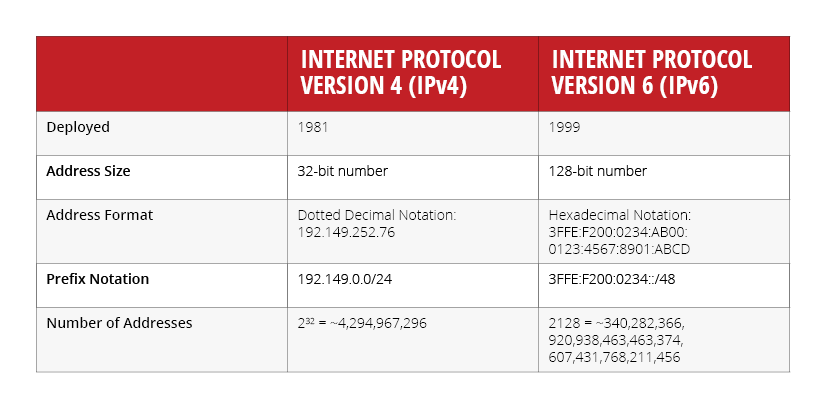So far we’ve discussed networks and protocols. Both have been fairly general topics. but now we come to something a little more specific: Internet Protocol (or IP) addresses, specifically with a focus on IPv4 (Internet Protocol Version 4).
Putting together our previous two discussions about networks and protocols, the Internet Protocol operates at Layer 3 of the network – this is the layer that deals with logical addressing and routing, making it possible to connect all the smaller local networks together into the global Internet.
We might say that IP addresses are similar to phone numbers or street addresses – they are unique identifiers that allow us to find and talk to a specific device on the Internet.
In practical terms, IPv4 addresses are just numbers, thirty-two-bit numbers to be precise. That means there should be a maximum of 232 or a little over 4 billion possible IP addresses. Except that there aren't, for a number of reasons. Some blocks of IP addresses are reserved for special purposes. And in the early days of the Internet, some companies and institutions were assigned massively large blocks that they didn’t need. The result, along with the huge proliferation of Internet-connected devices, is that we’re running out of addresses (though this is not yet the crisis some have made it out to be).
The ultimate solution to the exhaustion of the IPv4 address space is to switch the world over to IPv6, a “newer” (actually it’s been in the works for almost 20 years) version of the Internet Protocol using a 128-bit addressing scheme that is virtually inexhaustible. But it’s no small matter to move the entire Internet over to a new protocol with adoption being relatively slow. For now, the bulk of the Internet still runs on IPv4.

IP addresses are managed by five Regional Internet Registries (RIRs) which are divided geographically. Here in North America, IP addresses and AS numbers (Autonomous System numbers, used for BGP routing) are administered by ARIN, the American Registry for Internet Numbers. Internet Service Providers (such as Whipcord) apply to ARIN to receive allocations of public IP addresses. Or at least they used to; ARIN no longer has any unassigned IPv4 address space to dole out, but there are alternatives. A market exists for buying and selling IPv4 addresses, and ARIN will transfer these resources between old and new owners.
There are certain ranges of IPv4 addresses that have been set aside for private networks which are not directly reachable over the Internet. You’re probably familiar with these from your home network; addresses such as 192.168.1.1. These private ranges can be re-used by many different private networks, which is a necessity given the lack of available addresses. In a future post we’ll talk about firewalls and Network Address Translation, a clever hack that has made this IP re-use possible.
In this post we’ve taken a very general look at IP addressing, but we’ll revisit this topic in more detail in future posts since it’s so fundamental to more advanced IT concepts. In the meantime, if you’re curious to know what your unique public Internet Protocol address looks like, visit the chicken to find out (or, for a perfectly serviceable but much less amusing result, just google “what’s my IP”).
-1.png?width=1092&height=792&name=logo%20(1092x792)-1.png)
%20copy(black%20letters).png?width=1092&height=792&name=logo%20(1092x792)%20copy(black%20letters).png)




.png?width=100&height=91&name=white%20logo%20(100x91).png)